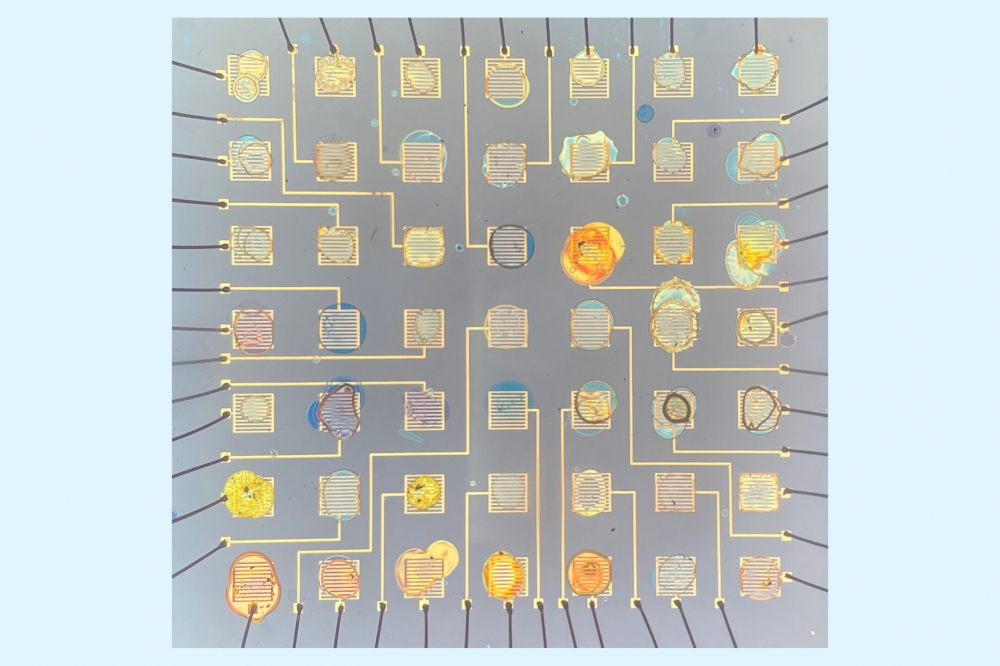Berkeley team develops multicoloured light-emitting array

With limitless colours, device may lead to advances in spectroscopy
Multicoloured light-emitting arrays could be useful in low-power sensing, computing and spectroscopy, but too often their spectral range is limited to a few colours due to material and device constraints. Now, Berkeley engineers have devised a way to produce an economical and compact light-emitting device with limitless colours that could greatly increase resolution in spectral imaging.
In a recent issue of Science Advances, a team of researchers led by Ali Javey, professor of electrical engineering and computer sciences, demonstrated the first light-emitting array with 49 different colours on a single chip. This novel optoelectronic device is built on metal-oxide semiconductor (MOS) capacitors and uses electroluminescent materials to generate light spanning the visible to the infrared wavelength range.
According to Vivian Wang, lead author and a PhD student in electrical engineering and computer sciences, this work builds off the team’s accidental discovery many years ago: light can be generated from semiconducting materials by putting them on top of capacitors on silicon wafers, instead of using diodes.
“We wanted to know what else we could do with these light-emitting devices,” said Wang. “After putting different semiconducting materials on the devices, we found that we could get them to emit different ranges of light. This led us to build a big array of these devices, with all of these colours on one chip.”
Multicoloured light-emitting device arrays based on diodes, like LEDs commonly used in computer and television displays, have a complex and costly fabrication process that limits them to a few colours. Another consideration is size. Some semiconducting materials cannot be grown on a single substrate, so devices fabricated on separate chips must be glued together, resulting in a larger package.
The researchers, however, wanted to easily and economically scale light-emitting arrays to tens or hundreds of colours while keeping the device size at a nanoscopic scale. They solved this problem by developing arrays based on electroluminescent, alternating current-driven MOS capacitors, instead of conventional diodes.
By using a capacitor for the electrical component, their new device allows for a simpler, more compact structure. “Unlike diodes, our device needs only one electrode, not two, to contact the material,” said Wang. “This makes the fabrication process really easy because you don’t have to put an electrode on top of the material; it just needs to fit on a bottom electrode.”
In addition, light can be generated from many different semiconducting materials without requiring adjustments to the device structure. “We don’t have to choose special kinds of electrodes for certain kinds of materials, like you do with a diode,” said Wang.
Fabrication is further simplified by an automated process called microprinting, which the researchers used to easily dispense different colour emitters on a single chip. The emitters consist of molecular and quantum dot materials, which are semiconductor nanocrystals with tunable optical and electronic properties. Microprinting is fast and enables the array to scale to a vast spectral range.
The device’s ability to offer limitless colour options makes it highly versatile and a good tool for spectral sensing, which has applications in the consumer, industrial and medical sectors.
“If your array has only five different colours, you can’t get very fine-grained spectral resolution,” said Wang. “But if you can scale to 50 different colours, as with our device, you can achieve much better spectral resolution.”
In the study, the researchers demonstrated ways their light-emitting device array could be used for more precise spectral measurement. In one example, they illuminated an object under a microscope and then took an image of the reflected light. Using this data, along with numerical optimization algorithms, they could reconstruct a spectral image of the sample at a high resolution.
According to Wang, the future looks bright for these optoelectronic devices.
“We think this highly multicoloured light-emitting array might open up interesting applications we haven’t previously thought about,” she said. “Ultimately, it could be used to make different kinds of compact spectral sensors or little chips that could be used for spectral measurements in the future.”
Co-authors of this study are Shiekh Zia Uddin, a graduate research assistant, and Junho Park, an undergraduate researcher, both formerly in Javey’s lab. All authors are affiliated with the Materials Sciences Division at Lawrence Berkeley National Laboratory.
Reference
'Highly multicolored light-emitting arrays for compressive spectroscopy' by Vivian Wang et al; Science Advances Vol 9, Issue 16 (2023)


































